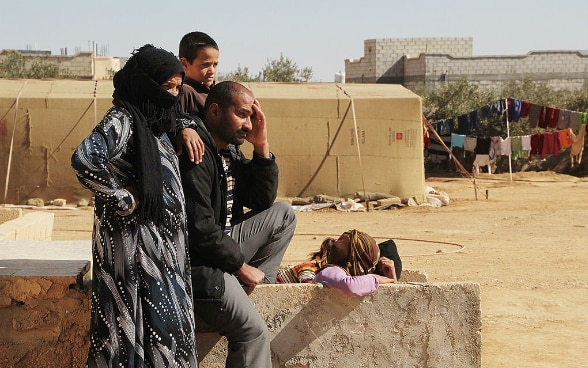
From the perspective of humanitarian aid for the victims of conflicts and natural disasters, these are frightening times. Humanitarian needs for 2015 alone amounted to almost CHF 20 billion (five times more than ten years ago), of which only half was raised.
The main crises today are characterised by their durations of many years as can be seen with the Syrian crisis, the persistent emergency situation in the Central African Republic and the ongoing acts of violence committed by the Boko Haram group against civilians. It is estimated that the number of forcibly displaced people in the world currently stands at 60 million.
Faced with this reality, the donor countries, international organisations and NGOs are obliged to set priorities and deal with the most urgent needs – this meaning that hundreds of millions of other people around the world see their basic needs (subsistence, education, health) remain unmet.
Long-term rehabilitation
In parallel, Switzerland, like others, is doing all it can to adapt its intervention strategies. For many years the SDC and the FDFA's Human Security Division have been actively involved in preventing conflicts and disasters by means of concrete initiatives carried out in the regions concerned.
When crises cannot be avoided, however, the SDC's Humanitarian Aid endeavours to launch projects that aim to contribute to the rehabilitation of vulnerable population in the long term. By means of support Switzerland helps beneficiaries to develop their own 'resilience', meaning their ability to confront difficulties and rebuild their everyday life – in many cases far from home.
At the World Humanitarian Summit, the Swiss delegation, headed by Federal Councillor Didier Burkhalter, will have the opportunity to present a number of successes Switzerland has had in this field (see below). Furthermore, Switzerland will appeal for greater respect for the values and principles of international humanitarian law.
Syria: employment aid, food vouchers and durable accommodation
Helping displaced Syrians to feel useful and earn a livelihood while contributing to the reconstruction of their country – this is the aim of a project launched by the United Nations Development Programme and co-funded by the SDC. In view of this protracted crisis, Syrians are unwilling to remain inactive for much longer.
The resilience of the victims of the Syrian conflict also involves developing new ways of providing food aid. In the cities of Homs and Latakia, the World Food Programme distributes vouchers to pregnant women and mothers with newborns, with which they are able to buy the kinds of food that best meet their needs. A member of the Swiss Humanitarian Aid Unit is coordinating the project.
Interview with Stefan Bumbacher, specialist working for the Swiss Humanitarian Aid Unit
The financial and technical support that Switzerland is providing the Office of the UN High Commissioner for Refugees (UNHCR) in Syria is crucial. The two years that building expert Henri Stalder spent in Damascus has enabled the UNHCR to draw up standards for 'solid' buildings in the midst of the ruins. Only when displaced Syrians have a proper roof over their heads will they be able to look to the future.
UNHCR-project in Syria: Rebuilding beyond the crisis
In general, Switzerland's involvement in the Middle East aims to complement the emergency aid delivered to Syria, Iraq, Jordan and Lebanon with a long-term vision of development for the populations concerned.
Darfur: producing honey against all odds
Almost three million Sudanese were forced to flee their land during the war in Darfur. Since 2010, the SDC has funded a programme to relaunch local beekeeping to enable displaced communities to become as financially autonomous as possible. It has paid off: to date, more than 3,300 family beekeeping operations are marketing their honey, which in some cases is generating up to CHF 2,900 a year.
Project in Sudan «Farmers displaced by the conflict acquire a business perspective»
Somalia: humanitarian aid to strengthen basic services
In 2016, the SDC has allocated CHF 4 million to support the ICRC's efforts in Somalia to raise awareness among various local actors about respect for international humanitarian law. The SDC is also improving the health systems, the drinking water networks and agricultural production in several parts of the country.
Somalia: the challenges of operating in a protracted crisis
Nansen Initiative: a long-term vision for displaced people
In October 2015, Switzerland and Norway presented the 'Agenda for the protection of cross-border displaced persons in the context of disasters and climate change', which was the product of the Nansen Initiative developed by Bernese professor Walter Kälin.
Preventive measures to help people displaced by natural disasters or the effects of climate change
